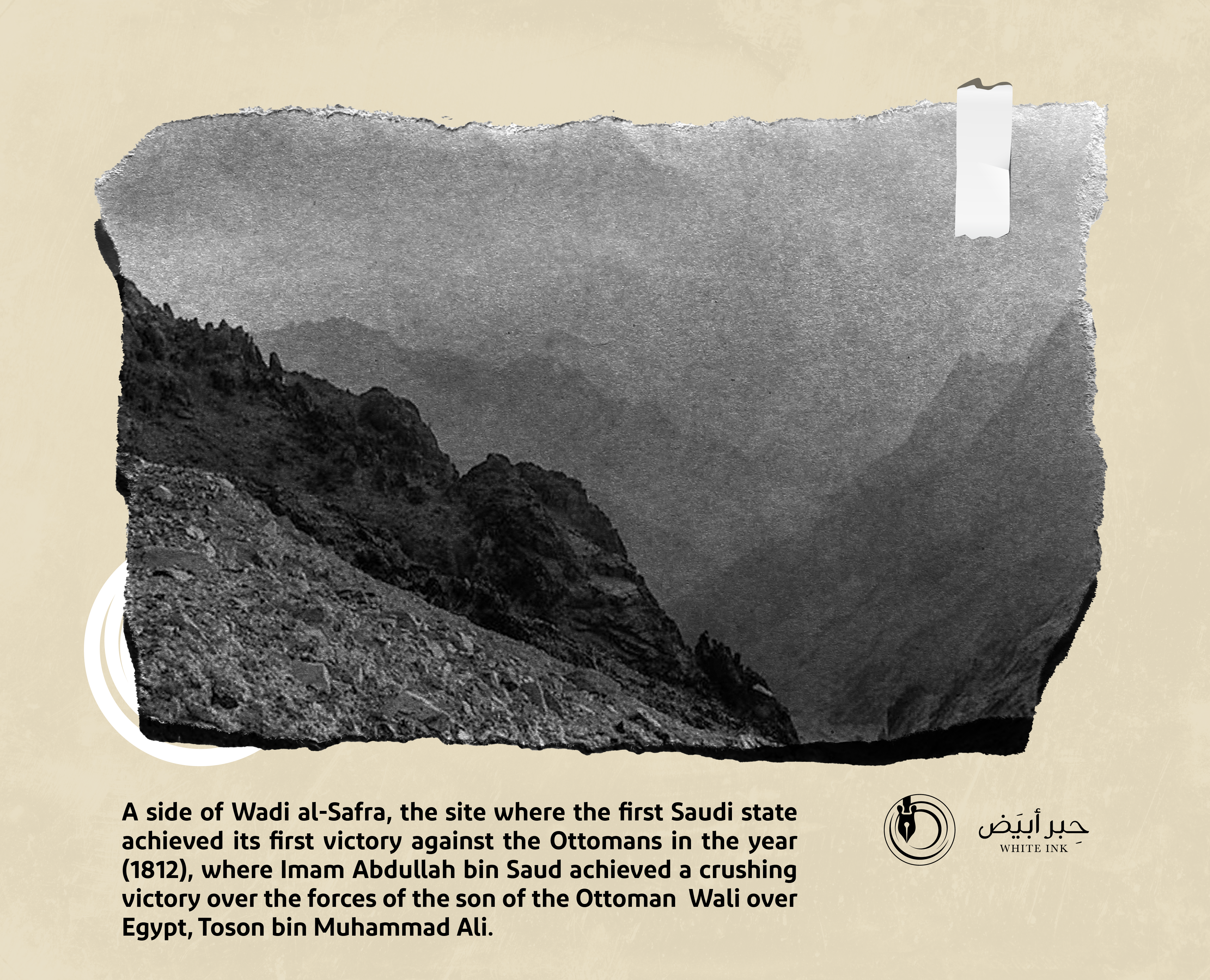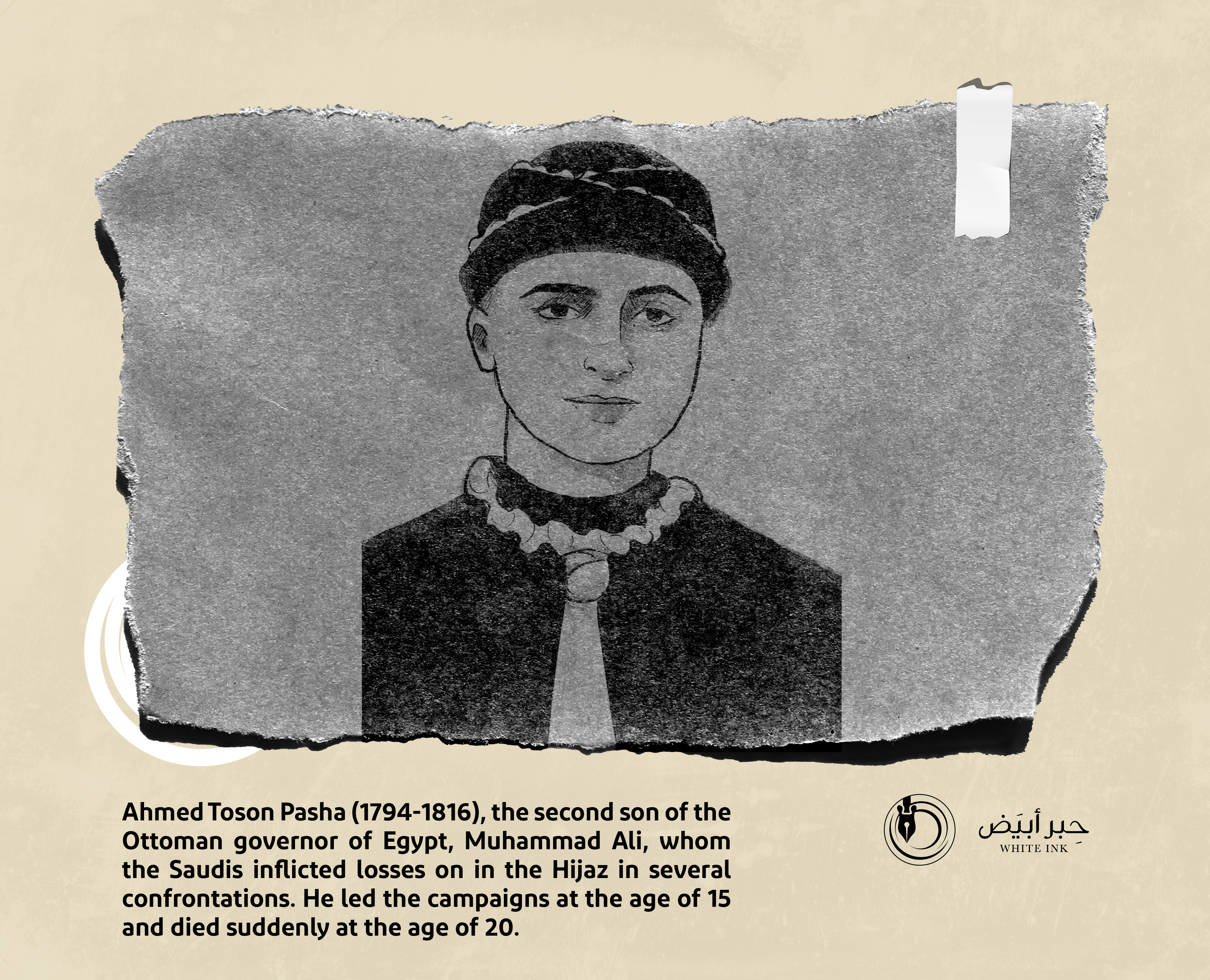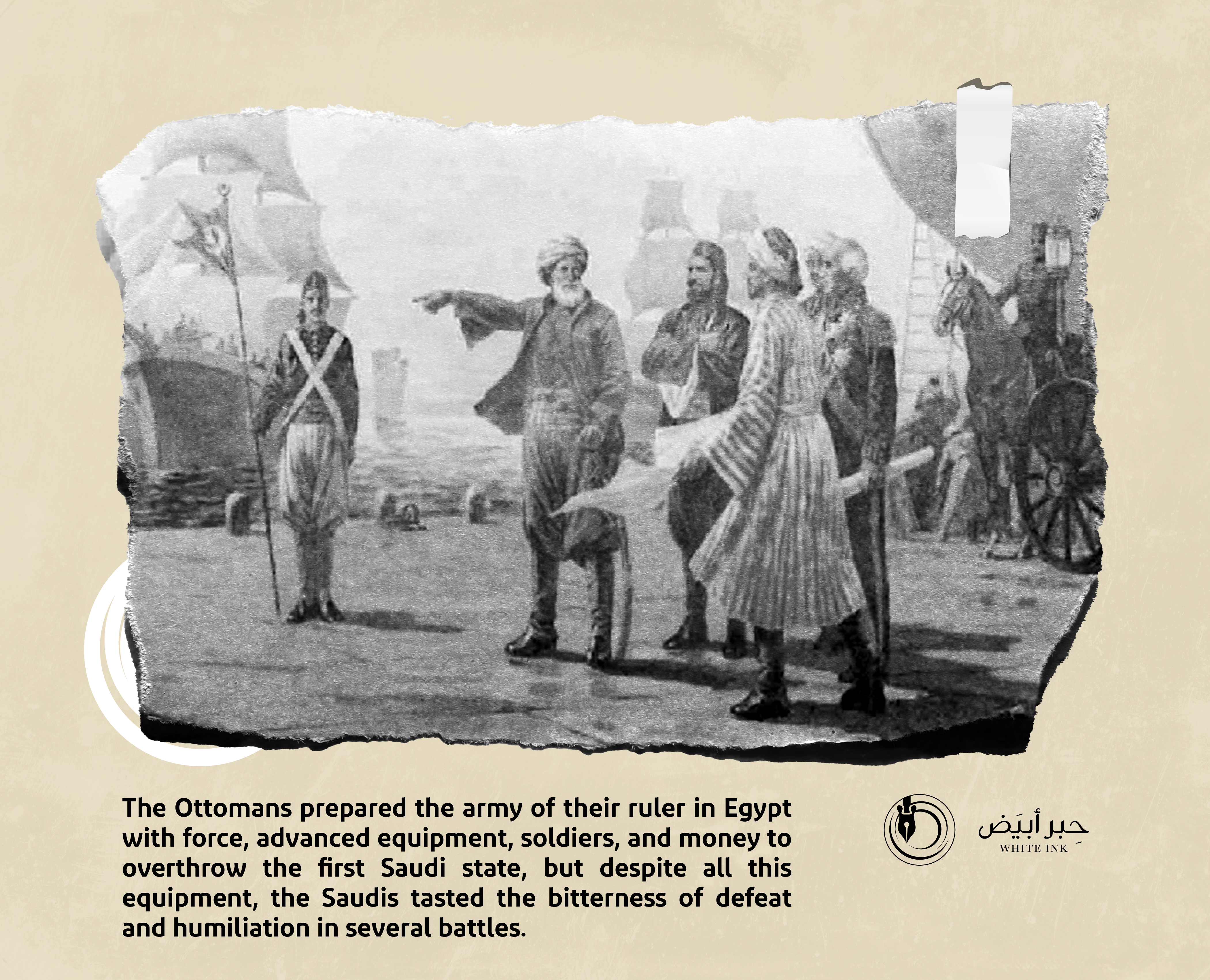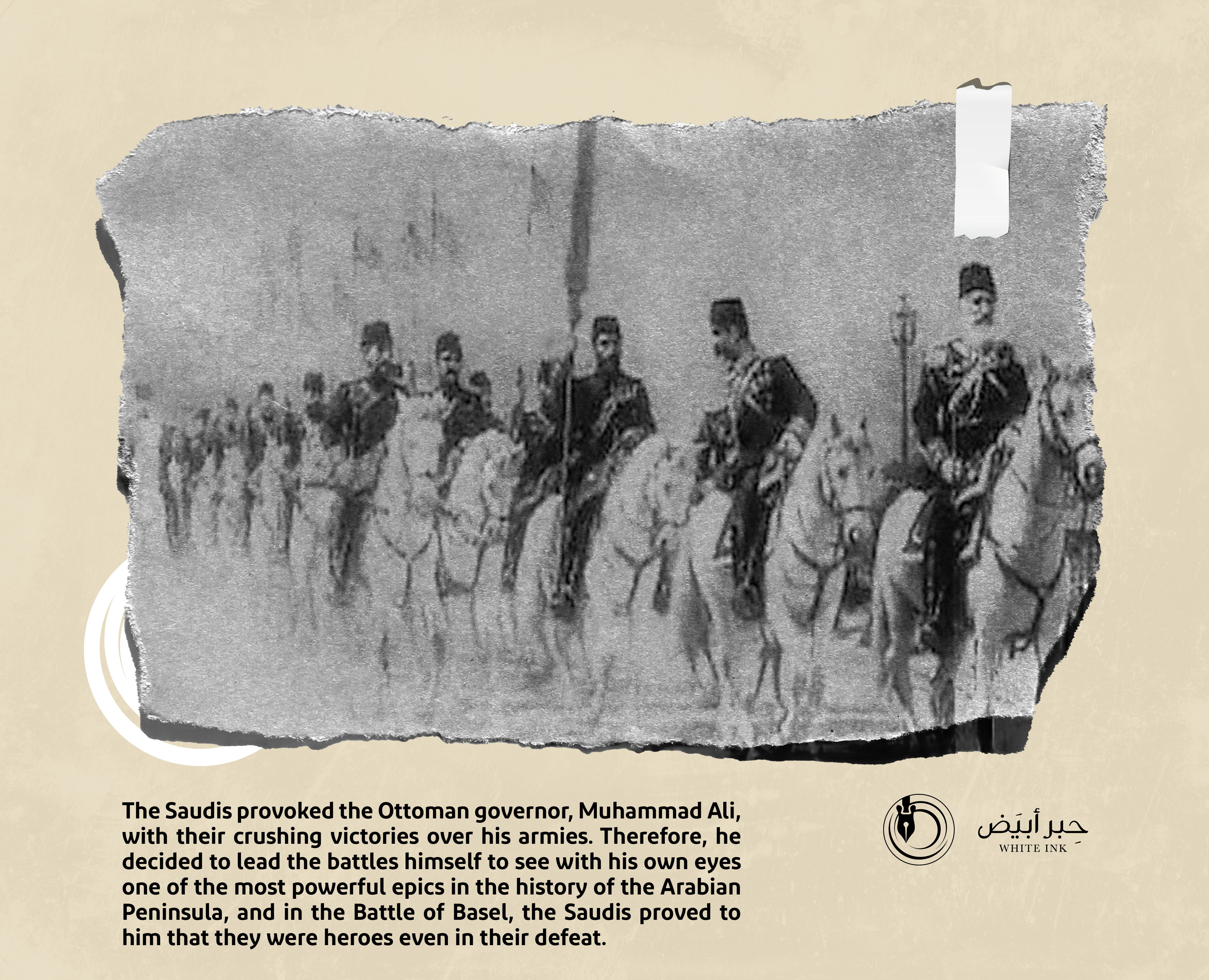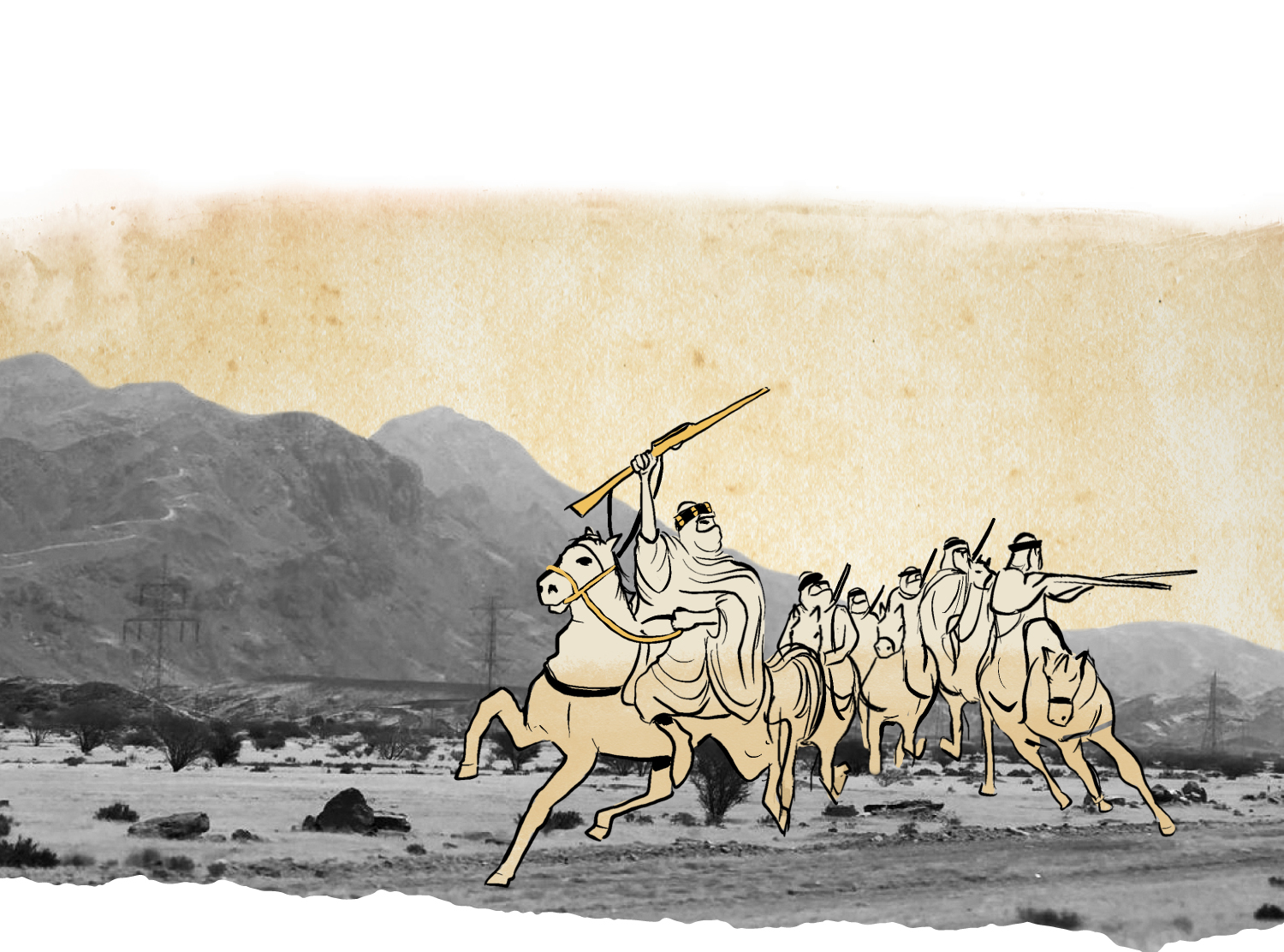
In a humiliating defeat to the Ottoman
"Wadi Al-Safra"... The Saudis defeated the trained army, which is armed with military tactics.
The Battle of Wadi Al-Safra in (1812 AD) is one of the first remarkable battles in the history of the first Saudi state. As for the geographical borders of the battle, Wadi Al-Safra is located on the road between the port of Yanbu on the Red Sea and Medina. The importance of this battle lies in the fact that it was the first Saudi victory over the first Ottoman campaign led by their governor on Egypt, Muhammad Ali Pasha, as the orders of the Ottoman Sultan were to confront the Saudis after they managed to recapture Hijaz; this battle is important for the Saudis; as it recorded their first victory over a systematic military campaign supported by all the Ottoman forces, personally led by the son of the Ottoman governor Muhammad Ali: Ahmed Tosun. The Ottoman governor believed that this battle was the first real test for his army in a rugged geographical environment, and that it was also the first real confrontation with the Saudi army, whose heroisms resonated in the Sultan’s palace and among his governors and was heard all over the world.
It was the first real test for the Ottoman forces against the forces of the first Saudi state.

The Ottomans prepared their campaign from Egypt in (1811) under Ahmed Tosun’s leadership, a campaign that consisted of an army of 8000 soldiers, 6000 infantry and 2000 cavalry, in addition to the military equipment that is considered advanced in a time dominated by strong artillery. According to the sources, the infantrymen were transported with military equipment on ships that sailed from the port of Suez to Yanbu, while the cavalry led by Tosun took the desert road through the Sinai Peninsula and northern Arabia.
Amin Saeed believes that the port of Yanbu was chosen as a primary target for the Ottoman campaign; Since it is the closest port of Hijaz to Medina; moreover, the capture of Medina quickly opens the door to Najd, to strike directly at the capital of the Saudi state.
The campaign landed in Yanbu without much resistance, due to the tactical withdrawal made by the Saudi ruler there; the plan was to confront the campaign after facilitating its landing in the port of Yanbu and opening the way for it to advance to the well-known Badr area near Medina, while the army of the Saudi state began to engage with the Ottoman army through small groups to lure the campaign with all its forces to the area Wadi al-Safra, which is geographically located on the road between Medina and Yanbu, where the Saudi forces are camped in preparation for confronting Tosun’s forces after they were exhausted on their way to the Saudi camp.
The Saudis forces were about ten thousand soldiers, while the forces of Tosun were about eight thousand. The Ottomans exceeded the Saudi army in terms of equipment, training and organization. having lured Tosun’s soldiers into the narrow valley, the Saudi forces had prepared a military plan commensurate with the geography of the valley, so Imam Abdullah bin Saud ordered his soldiers to dig a trench in the valley, and he was the commander of this battle during the reign of his father, Imam Saud bin Abdulaziz, so he and those with him camped in that trench, while Othman Al-Madhaifi, one of the leaders of the Saudi state in Hijaz – camped with the Saudi forces on the mountain overlooking the trench, and lured Tosun’s forces and surrounded them in this ambush; when Tosun and his forces tried to turn around and get out of this ambush and head back to the port of Yanbu; The Saudis rushed after them and inflicted heavy causalities, approximately five thousand soldiers, while the Saudi losses did not exceed six hundred soldiers.
The Saudi victory over the Ottomans resonated every wide and far, which disturbed the Ottoman governor Muhammad Ali greatly, and he tried to search for a logical justification behind the defeat of an army trained, prepared and armed with a very sophisticated military machine at its time against an army that had primitive equipment compared to them, and what makes matter worse for the Ottoman governor that his army incurred great casualties, so Muhammad Ali sent his son Tosun inquiring about the mystery behind the humiliating defeat of the Ottomans. He only found that the reason for the defeat should be attributed to the recklessness of his leaders, and that they were not single-heartedly unity, saying: “They were the cause of the defeat due to their differences and competition.”
The Ottomans attributed their defeat to the differences between their leaders, rivalries, and conflicts.



- Othman bin Bishr, Title of glory in the history of Najd, achieved by: Abdul Rahman Al Sheikh, 4th ed (Riyadh: Ministry of Education, 1971).
- Abdul rahman Aljabart, Date of Jabarti named the wonders of monuments in biographies and news, achieved by: Abd al-Rahman Abd al-Rahman (Cairo: Egyptian National Library, 1997).
- Ameen Saeed, State History Saudi Arabia (Beirut: Dar Alkitab Alarabe Publishing, without date).
- Abd al-Rahim Abd al-Rahman, The First Saudi State, 5th ed (Cairo: University book house, 1987).
- Al-Sayed Farag, Wars of Muhammad Ali (Cairo: Al-Tawakkal typing center, without date).
- Abdul fattah Hassan Abu Alih, Lectures in the history of the first Saudi state, 2nd ed (Riyadh, Dar Al Mareekh, 1991).
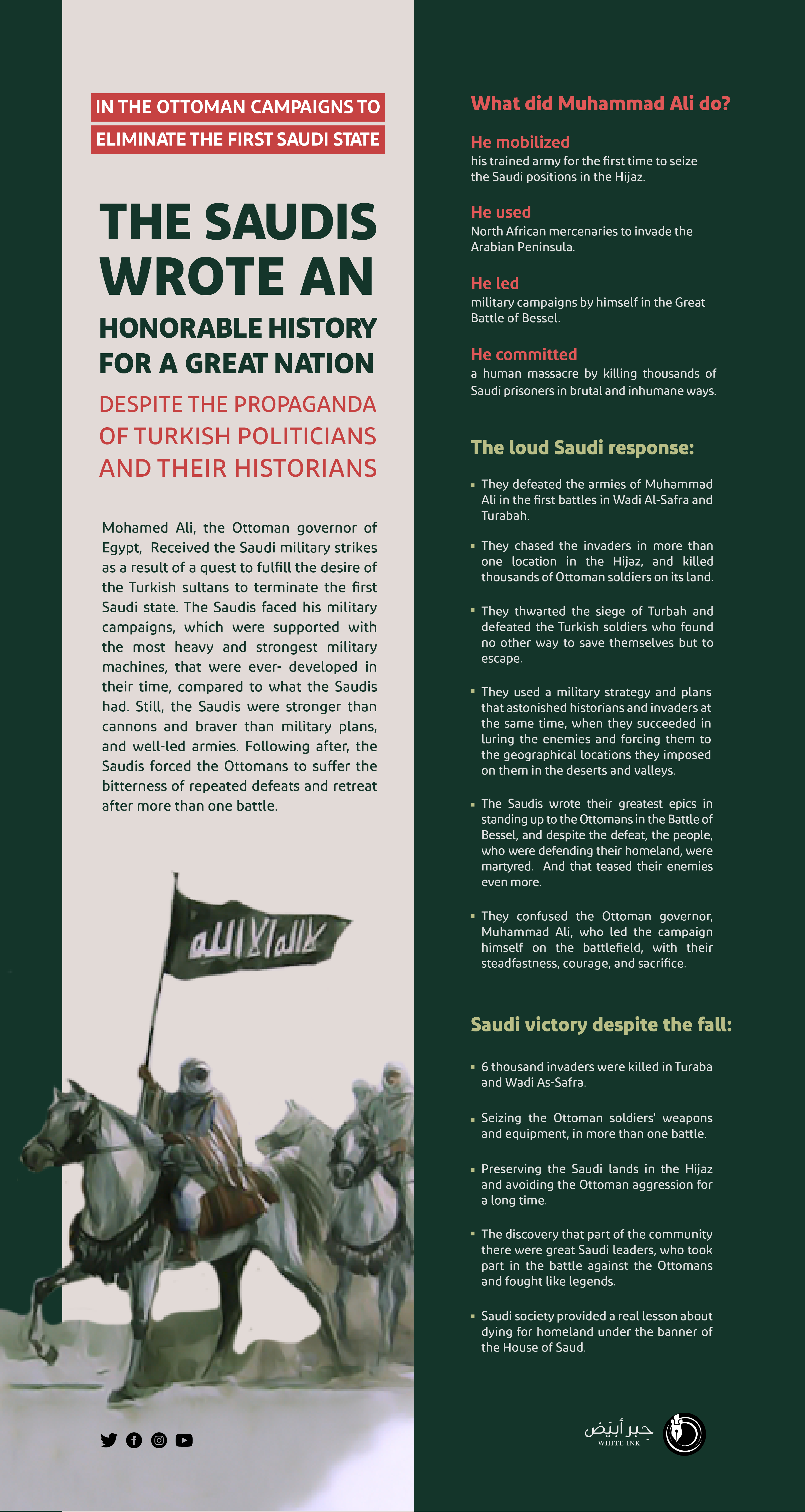
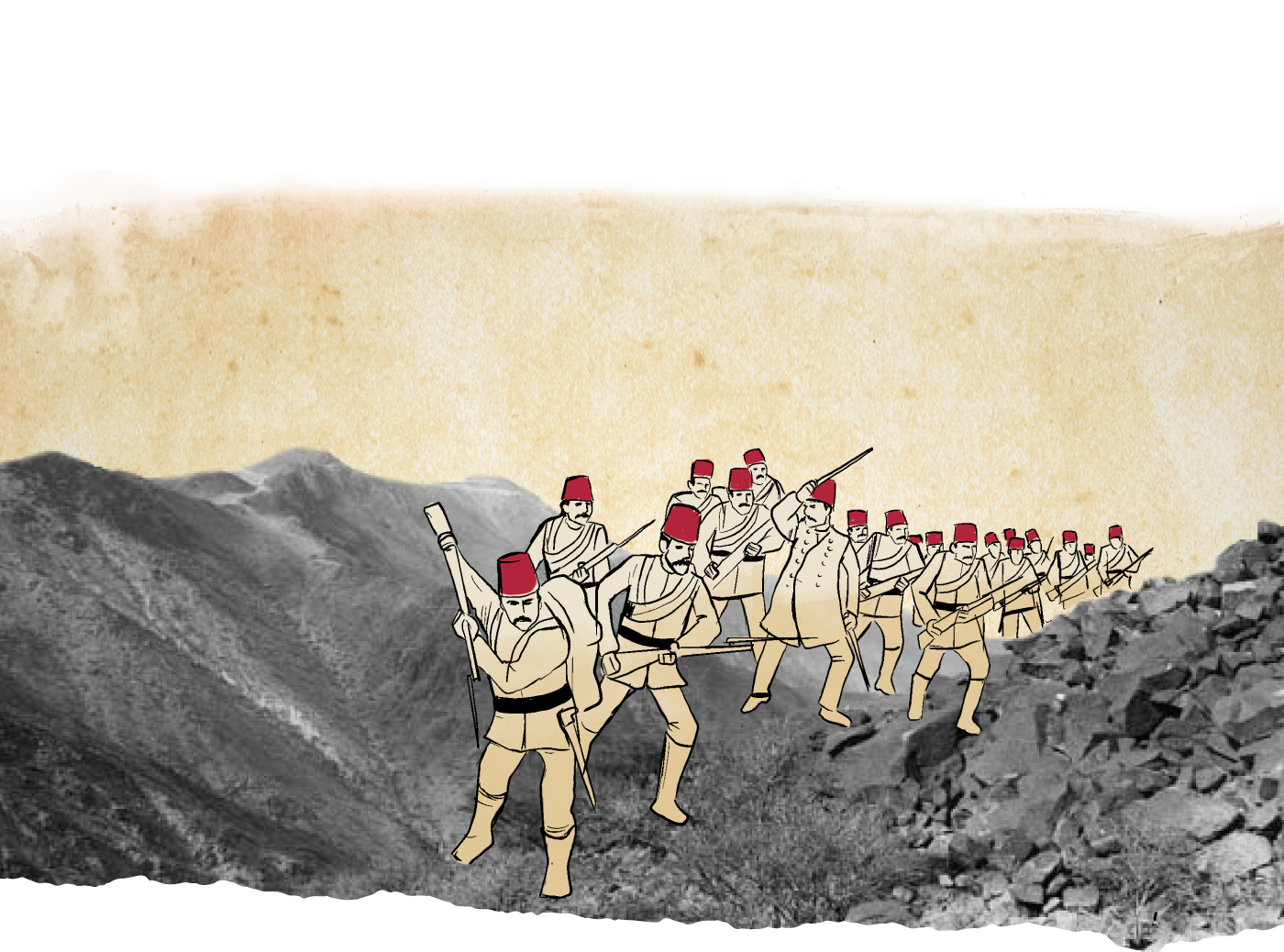
The Saudis, even in their defeat, were heroes who wrote history with their blood
Battle of Bessel. The Saudi epic battle that proved to the Ottomans that souls are the first fortresses of the homeland
The Saudis valiantly defended their first country against the invaders of the Turks, despite the fact that the Ottomans equipped their armies with powerful equipment and an uninterrupted supply of military soldiers and mercenaries, and all their states were in a state of alert to achieve their goal of overthrowing the capital of the first Saudi state, Diriyah. The Battle of Basel, in which the Saudis scored an unparalleled glory in the era of the first Saudi state.
Wadi Basel is located between Taif and Al Baha, in the middle of the distance between Turubah and Taif, and is surrounded by a mountain range that forms a natural barrier for those heading to Turubah and Najd.
The Battle of Basel took place in this valley two years after the defeat of the Ottoman army in the second battle of Turubah, which the Ottoman commander Mustafa Bey thought it was within his reach, until the Saudis tasted him the bitterness of defeat and forced him to retreat. Despite the defeat of the Ottomans in Turubah, they rushed to prepare other military campaigns, but this time under the leadership of the Ottoman governor of Egypt, Muhammad Ali Pasha in person, trying to break the fear in the hearts of his soldiers who began to collapse before the strikes of the Saudis, and in order to personally eliminate the Saudis in Hijaz. Taif in particular, whose fall would open a road to the capital of the first Saudi state, Diriyah.
The Battle of Basel took place in January (1815 AD) between the forces of the first Saudi state led by Prince Faisal bin Saud bin Abdulaziz and the Ottoman army led by the Ottoman governor Muhammad Ali Pasha, who marched to invade the Saudis on the orders of the Ottoman Sultan Mahmud II, after the first Saudi state was able to bring Asir and Hijaz together.
Historians described Basel as the greatest epic battles of the first Saudi state with the Ottomans, due to its military details and the forces mobilized for it, and because it was a cornerstone that opened the way for the invading Ottomans to pounce on Diriyah.
The Ottoman governor committed a human massacre by cutting off 5,000 heads of Saudi prisoners.

Muhammad Ali Pasha promised the Ottoman Sultan in Istanbul to eliminate the first Saudi state, which exhausted the Sultan’s forces in Iraq, Al-Ahsa and the Levant, and because it turned into a threat to his sultanate.
Muhammad Ali faced Prince Faisal bin Saud, commander of the Saudi forces, on behalf of his father, Imam Saud, who died days before the decisive battle, continuing the march under the banner of his brother Imam Abdullah bin Saud.
The Saudis marched from Najd with their leader Faisal bin Saud, and other numbers from different tribes who owed allegiance to the first Saudi state joined him. The Saudi leader Tami bin Shuaib and a large number of Asir tribes, Fahd bin Salem bin Shakban from Bisha, and Ibn Dahman came with him along with many battalions from the horsemen of Ghamid tribe, and Muslat bin Qatanan al-Sabi’i from Ranyah, Ibn Hatamil from Shahran, Bakhrush bin Alas from Zahran, and many other leaders of the Hijaz tribes and their knights. These forces were about twenty-five thousand.
The epic battle began with a meticulous Saudi plan to eliminate the Ottoman army and Muhammad Ali Pasha; so, they rumored that an army was advancing from Qunfudhah towards Jeddah in an effort to seize it, which confused the Ottoman army and prompted many of them to flee. After this diversion put on by the Saudis against the Turks and directing their attention towards Al-Qunfudah They attacked the Turks at Bessel and broke through the lines of the Ottoman army, which prompted Muhammad Ali Pasha to retreat.
Historians know it as the greatest Saudi epic battles against the Ottoman occupier.

Muhammad Ali tried his best, through his cavalry, to affect the plan of the Saudis, but he failed. After the first day of the battle had passed and the Turkish cavalry failed to make any progress, Muhammad Ali realized the strength of the Saudis and feared defeat; so, he hatched another plan, gathered his commanders, and ordered them to advance towards the Saudi posts, and when they reached the nearest point of engagement, they fired them up and retreated as if they were defeated, without any organization towards the valley – in an attempt to deceive the Saudi of their escape.
The Ottoman army executed the plan as hatched by the Pasha, and as soon as the Saudis saw the Turks retreating and the confusion among them, they left their fortified mountain posts and went down to the plain, and this is what Muhammad Ali expected, until the Saudis moved away from the mountains where they barricaded themselves and fighting from, so he sent his knights and stationed his forces and artillery over the mountains and bombed the Saudi army so that the battle ends in his favor.
Muhammad Ali made sure that most of his army would be North African Desert mercenaries who were experienced and trained to fight in the desert, as their number reached about twenty thousand fighters, including 1200 knights on their horses, hundreds of cannons and thousands of modern rifles that were not available to the Saudi army, in addition to 3000 camels from Levant, and 2,000 people from Libya to carry supplies that were estimated to be enough to fight two whole months.
Most of the Saudi army was from Saudi tribes, most of whose knights came to defend their state and homeland under one banner to fight the Ottoman occupier, and the Saudi forces were more than 25 thousand fighters, most of them infantry, in addition to old and personal rifles and without cannons.
The Battle of Basel was recorded as one of the major battles waged by the first Saudi state in defending its lands against the invading Ottoman occupier, who came from outside the Arabian Peninsula with its men, equipment, mercenaries and modern weapons, to occupy lands he did not own and had no right to. At a historical stage in the life of the Arabian Peninsula, during which it was united under the Saudi flag, the Battle of Basel was not the only confrontation with the Ottoman occupier, but rather was part of a major war whose battles took place throughout the territory of the Saudi state, from Medina and Yanbu to Jeddah and Makkah, and along the coast of the Red Sea in Qunfudhah, Tihama and Asir.
The Turkish trick caused the Saudi forces to descend from the high mountains, with a desire to eliminate the Turks once and for all and to arrest Muhammad Ali, which made them forget the correct military system they had adopted, and the surprise that awaited them when this large number of Turkish cavalries emerged and the artillery bombardment, all that made them lose the ability to resist.
The End of the Battle:
After the end of the battle, part of Faisal bin Saud’s army retreated to Turubah, while the rest dispersed and returned to their areas, especially to Al-Baha and Asir, and Muhammad Ali’s army followed them to Turubah, and when Prince Faisal knew of this, he retreated from it to Ranyah, and from there to Najd, while Muhammad Ali continued marching, occupying Turubah, Ranyah, Bisha and Asir.
The Ottomans committed major massacres against the prisoners of the Saudi army, and Muhammad Ali Pasha placed a reward of 6 gold pounds for each head of a Saudi fighter. In a few hours, five thousand severed heads of the Saudi martyrs who were martyred on the battlefield were piled up in front of him.
Despite the bitterness of defeat and the dispersal of the knights and their retreat inward, the Saudis made history full of heroic actions that history still preserves to today, including that the knight Fahd bin Salem bin Shakban from Bisha and some of his hundreds of men managed to penetrate the Turkish blockade and retreat safely to their areas. Also, Commander Ibn Raqosh, one of the leaders of Zahran, killed a number of the Ottoman governor’s officers with his own hands, and when he lost his horse, he waited until he had the opportunity to throw a Turkish cavalry off his horse, so he rode it and retreated with his fighters to his home. The Asiri forces set the greatest example of sacrifice, as the sources say that many of them were found dead tied with ropes in the mountains adjacent to Wadi Basel, after they tied their own feet, swearing by God not to flee away from the Turks, and they fought until the last breath, to remain in that condition and end up being a symbol of the great martyrs of the homeland, who wrote history with their blood.
The martyrs handcuffed themselves in the battlefield, in the face of death.



- Abd al-Rahim Abd al-Rahman, The First Saudi State, 5th ed (Cairo: University book house, 1987).
- Abdul fattah Hassan Abu Alih, Lectures in the history of the first Saudi state, 2nd ed (Riyadh, Dar Al Mareekh, 1991).
- Othman bin Bishr, Title of glory in the history of Najd, achieved by: Abdul Rahman Al Sheikh, 4th ed (Riyadh: Ministry of Education, 1971).
- Fylks Manjan, the history of the first Saudi state campaigns Mohammad Ali on the Arabian Peninsula, translated by: Muhammad Khair Al-Beqai (Riyadh: King Abdulaziz Foundation for Reasearch and Archives, 2003).
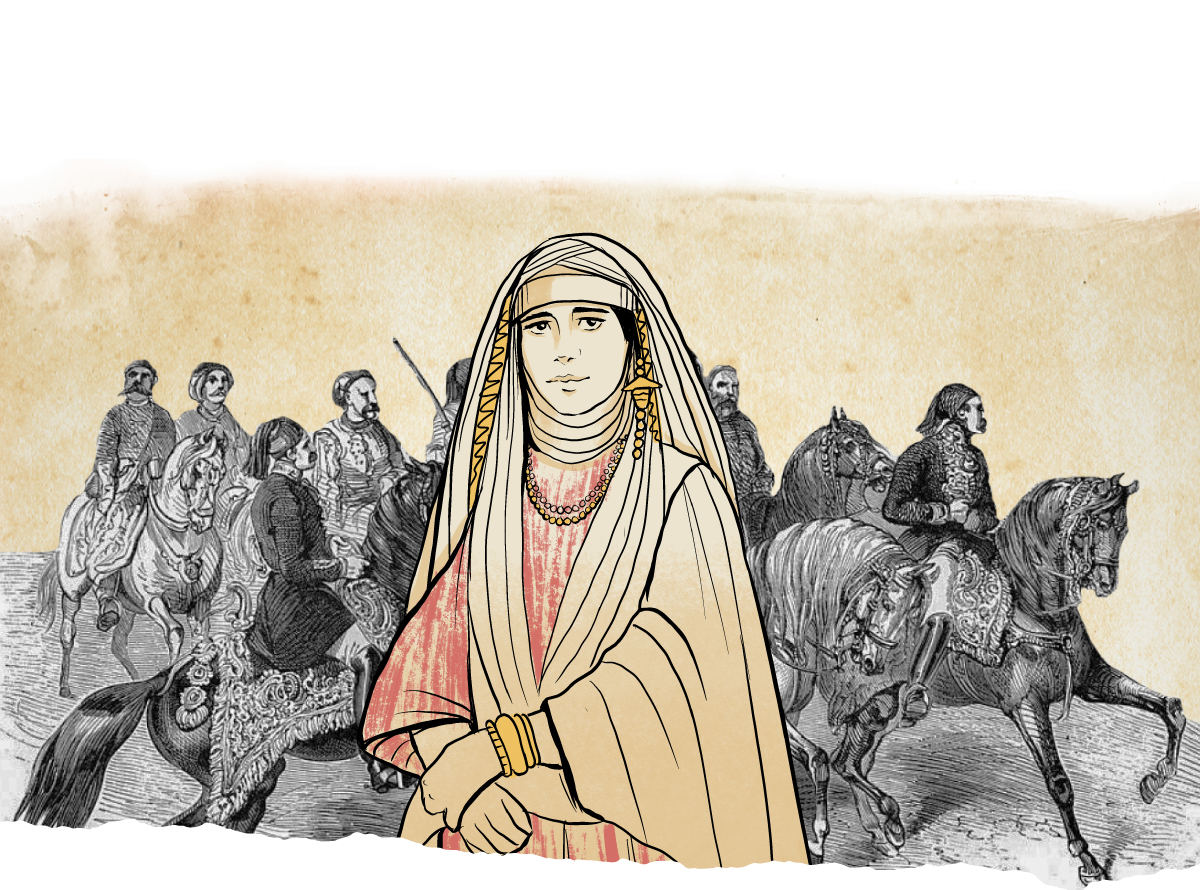
It was an important base for the state army in confrontation of the Turkish invaders
“Turubah” the Saudi city Defeated the Ottomans twice
The orders of the Ottoman Sultan Mustafa IV to his governor of Egypt, Muhammad Ali in (1807 AD) to destroy Diriyah – the capital of the Saudi state – were direct and straightforward, in order to eliminate the first Saudi state that embarrassed the Ottomans. This is what was indicated by Egyptian National Library and Archives, which revealed that Muhammad Ali Pasha sent his apology to the Sultan for his inability to fulfill his request to carry out the mission, due to the deteriorating economic situation in his state, and his fear of the ambitions of European countries.
The Sultan induced his Governor, Muhammad Ali that he would be in the interest of the Ottoman Empire, which would bless his state and raise its prestige and his, as the ruler of Egypt. After the persistence, the governor had no choice but to respond to the Sultan’s desire to attack the first Saudi state, which tasted them the first defeat in Wadi Al-Safra (1812 AD), and forced the commander of the campaign, Ahmad Tosun, to flee with those remained of his army to Yanbu, asking for help and more soldiers after losing their gear and equipment. The Egyptian historian Abdul rahman Aljabart elaborates that Tosun counted his soldiers who arrived to Yanbu alive after they fled away from Wadi al-Safra, only to find three thousand after they were eight thousand.
First Battle of Turubah:
During the period of Tosun’s presence in Yanbu, they supplied him with more soldiers and gear again, so he was able to move and occupy Makkah in (1813), and two weeks later, he was able to occupy Al-Ta’if.
The forces of the first Saudi state at that time, had adopted a military strategy that was to lure the invading Ottoman forces into the lands of the Arabian Peninsula, where deserts and valleys were, in addition to keeping them away from supply centers and supply lines, so that they would be defeated easily, as happened to them in Wadi al-Safra, and Ibn Bishr narrates about the first Ottoman campaign on the town of Turubah, by saying: In Sha’ban (1228 AH / 1813 AD), the Egyptian soldiers gathered from Makkah and Taif, and Mustafa and Rajah al-Sharif marched with them in crowds of Al-Bawadi who breached their promise and pledged allegiance to the Turks. Those crowds marched with cannons and bombs, and they headed to the town of Turubah, where the people of Najd and others were stationed, and the Turks besieged it for three days, then came help from the people of Bisha and others to the people of Turubah. The Saudis’ ambushed and encountered them; so, the Saudis came out on the station and the tents, and these soldiers and crowds were defeated, so the Saudis seized their station and their tents, and many of them were killed, and they returned empty-handed.”
Here a question arises about the importance of the town of Turubah, which caused the invading Turkish forces to attack it with large forces? The answer is that Turubah was an important base for the Saudis on the road connecting Hijaz and Najd, as it is actually the gateway of Hijaz to Najd, and an important center to strike the invading Ottoman forces towards the middle Najd; therefore, Mustafa Bey was keen to launch a campaign on Turubah in order to cut off the road for the Saudis to resist the movements of the campaign army.
The command center, which was operated by Imam Saud bin Abdulaziz, was directing the movements of the Saudi army, which preceded the Turks in imposing its method and strategy.

The French, Felix Mangane, indicates that Imam Saud bin Abdulaziz ordered his son Faisal to lead a military force and not to confront his enemies except in the Turubah, and to keep some of his forces to holed up in Bisha, and to station Al-Haganah and cavalry in the straits, in a manner that would facilitate blocking the way for the invading forces. The Saudi leadership has made Turubah a fortress, waiting for the invaders to come and confront them.
The Ottoman invaders arrived and besieged Turubah for three days, but the Saudi forces held out inside the fortified town. Ghaliyya Al Bogammiah had a role in lifting up the spirits of the town’s defenders from the men of her tribe, Al-Baqom, as the sources mention that she went out leading a team of her men to confront the invaders, and this coincided with the arrival of the Saudi forces from the Bisha, led by Abdullah bin Saud and Salem bin Shakban.
The two sides met in Wadi al-Saleem, in which a fierce battle took place, ended with the expulsion of the Turks and their flight to Al-Taif, heading back with their tails between their legs, leaving behind many dead and spoils. As a result of that battle, Wadi al-Saleem was known after the battle with Wadi “Rayhan” as it was filled with dead bodies of the Ottoman army; the number of dead was between six hundred to a thousand dead, approx., and Mangan referred to the defeat by saying: “Mustafa Bey lost his artillery and luggage, and his defeat was nothing less than the defeat of Al- Safra Straits.
Second Battle of Turubah:
After the awful defeat of the Ottomans in Turubah, Muhammad Ali Pasha decided to send another campaign led by Tosun, commander of the forces in Hijaz, who marched in February (1814 AD) with large forces. Historians differed in their number between five thousand infantry fighters, one thousand horsemen and six cannons, and between three Thousand of fighters with his gears and equipment, and Tosun accompanied his most prominent leaders such as Abdin Bey and Thomas Keith, the financial officer of the campaign, and one of the local leaders loyal to the Ottomans, and he was at the same time resentful of the actions of Muhammad Ali Pasha. In order to avenge him, he took the campaign on a long way to run out of supplies, and the soldiers and animals suffered, in addition to the dangers of the road and the invasions of the Bedouin against them.
After that exhausting march of the Ottomans, Tosun and his army arrived to Turubah, and ordered to attack the town, and did not give his soldiers a chance to rest; rather, the blockade was imposed for four days, according to what Ibn Bishr said, and he was unable to enter it, due to the extraordinary courage shown by the Saudi unity who maintained the walls of the town, led by Ghaliyya Al Bogammiah heroically and with rare valor. The Ottoman stance became more difficult after the retreat of local leaders loyal to them, led by Sharif Rajeh Al-Shanbari, who decided to join the army of the Saudi state defending Turubah.
Ghaliyya Al Bogammiah terrorized the Turks with the power of the Saudis, and aided them to hold on to and defend their homeland.

At that time, Tosun and his men felt powerless to penetrate the walls of the Turubah, and all their attempts failed, and when Tosun decided to strike by force, his officers warned him to the danger of this, due to the lack of supplies and ammunition, so he had to lift the siege from the town and retreat at night; however, he incurred great losses as a result of the vicious attack of the Saudi defenders when they came out from the town and took over the roads and passages, this caused the ones retreating to get confused and began to escape, trying nothing but to escape, while the Ottoman army almost perished from that attack.
In Turubah, the Saudis defeated and humiliated the Turkish invaders once again, which caused a negative impact among the members of the Ottoman army, whose leaders and soldiers began taunting each other and attaching the causes of defeat to each other. This Saudi victory also had a violent impact in the country of the Ottoman Sultan and his governor in Egypt, Muhammad Ali.


- Brydjz, A brief history of the Wahhabi, Translate: Owaidah Al-Juhani (Riyadh: King Abdulaziz Foundation for Reasearch and Archives, 2005).
- Dalal Alharbi, Ghaliyya Al Bogammiah, her life and role in resisting the campaign of Muhammad Ali Pasha in Turubah (Riyadh: King Abdulaziz Foundation for Reasearch and Archives, 2012).
- Abd al-Rahim Abd al-Rahman, The First Saudi State, 5th ed (Cairo: University book house, 1987).
- Abdul fattah Hassan Abu Alih, Lectures in the history of the first Saudi state, 2nd Ed (Riyadh: Dar Al Marrekh, 1991).
- Othman bin Bishr, Title of glory in the history of Najd, achieved by: Abdul Rahman Al Sheikh, 4th ed (Riyadh: Ministry of Education, 1971).
- Fylks Manjan, The history of the first Saudi state campaigns Mohammad Ali on the Arabian Peninsula, translated by: Muhammad Khair Al-Beqai (Riyadh: King Abdulaziz Foundation for Reasearch and Archives, 2003).


